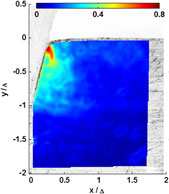Crossref Citations
This article has been cited by the following publications. This list is generated based on data provided by
Crossref.
Yeung, Ho
Guo, Yang
Mann, James B.
Dale Compton, W.
and
Chandrasekar, Srinivasan
2016.
Effect of Low-Frequency Modulation on Deformation and Material Flow in Cutting of Metals.
Journal of Tribology,
Vol. 138,
Issue. 1,
Sundaram, Narayan K.
Mahato, Anirban
Guo, Yang
Viswanathan, Koushik
and
Chandrasekar, Srinivasan
2017.
Folding in metal polycrystals: Microstructural origins and mechanics.
Acta Materialia,
Vol. 140,
Issue. ,
p.
67.
Sundaram, Narayan K.
2018.
Deformation field in deep flat punch indentation and the persistence of dead-metal zones.
Philosophical Magazine,
Vol. 98,
Issue. 25,
p.
2326.
Deshpande, Kedar
Mirasdar, Shailesh
and
Patkar, Vivek
2019.
Advanced Computational Simulations for Upstream Oil & Gas Applications.
Sundaram, Narayan K.
2019.
Mechanics of plastic flow past a narrow-angle wedge indenter.
Philosophical Magazine,
Vol. 99,
Issue. 23,
p.
2883.
Udupa, Anirudh
Sundaram, Narayan
Sugihara, Tatsuya
and
Chandrasekar, Srinivasan
2019.
Direct <i>In Situ</i> Observation of Deformation Modes in Wedge Indentation of Metals.
MATERIALS TRANSACTIONS,
Vol. 60,
Issue. 8,
p.
1442.
Vandana, A.S.
and
Sundaram, Narayan K.
2020.
Simulation of machining of ductile polycrystalline aggregates using a remeshing framework.
Journal of Manufacturing Processes,
Vol. 54,
Issue. ,
p.
1.
Kuroda, Mitsutoshi
2022.
Plane strain wedge indentation revisited.
Proceedings of the Royal Society A: Mathematical, Physical and Engineering Sciences,
Vol. 478,
Issue. 2262,
Kuroda, Mitsutoshi
2023.
Characteristic material behaviors in conical indentation with friction.
ZAMM - Journal of Applied Mathematics and Mechanics / Zeitschrift für Angewandte Mathematik und Mechanik,
Vol. 103,
Issue. 10,
Das, Debasree
and
Sundaram, Narayan K.
2024.
Effect of a subsurface void on the micromechanics of ductile metal indentation using remeshing.
International Journal of Solids and Structures,
Vol. 297,
Issue. ,
p.
112842.


